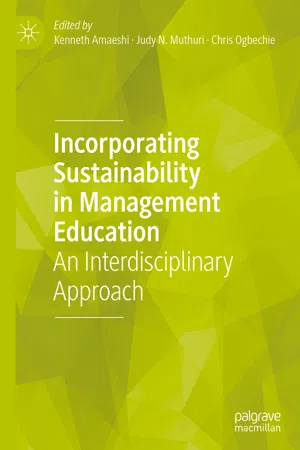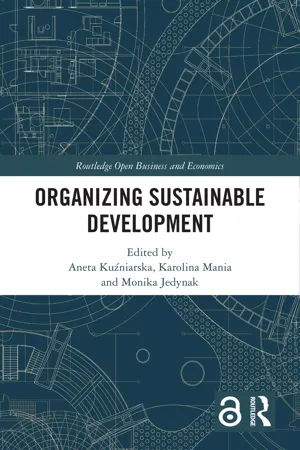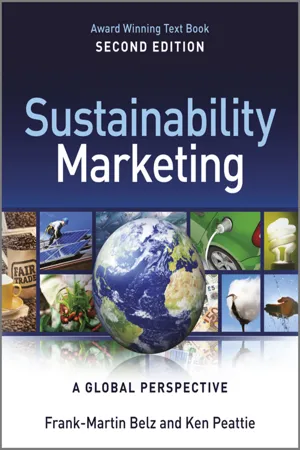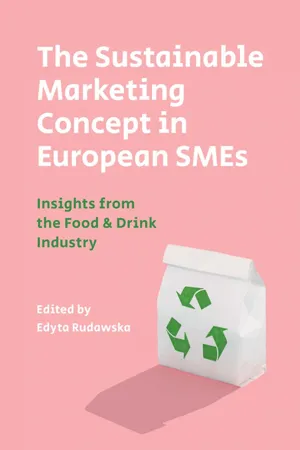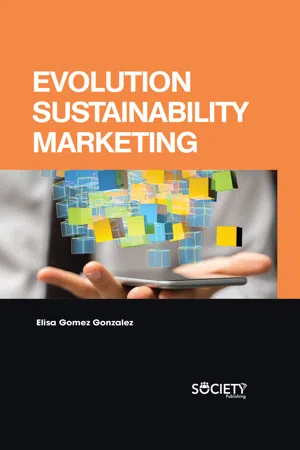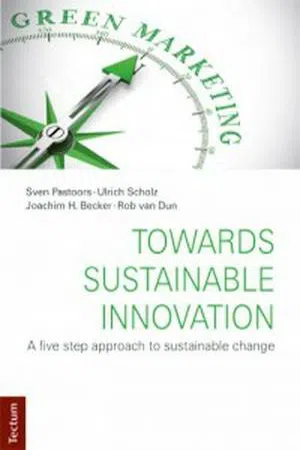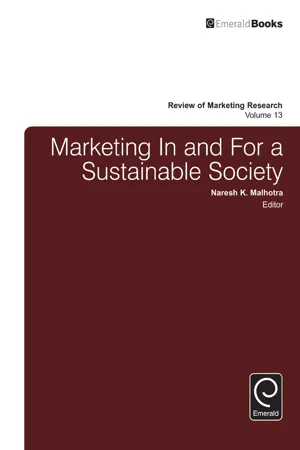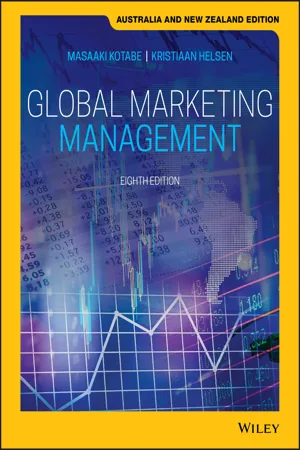Marketing
Sustainable Marketing
Sustainable marketing refers to the practice of promoting products or services in a way that minimizes negative environmental and social impacts. It involves incorporating sustainable principles into all aspects of marketing, from product development to promotion and distribution. This approach aims to meet the needs of the present without compromising the ability of future generations to meet their own needs.
Written by Perlego with AI-assistance
Related key terms
1 of 5
11 Key excerpts on "Sustainable Marketing"
- eBook - ePub
Incorporating Sustainability in Management Education
An Interdisciplinary Approach
- Kenneth Amaeshi, Judy N. Muthuri, Chris Ogbechie, Kenneth Amaeshi, Judy N. Muthuri, Chris Ogbechie(Authors)
- 2019(Publication Date)
- Palgrave Macmillan(Publisher)
Discussing with students some of these definitions helps to highlight the strong managerial focus that understanding of the phenomenon tends to maintain (see also McDonagh and Prothero 2014), which may lessen the perceived urgency of the environmental and social matters at stake. Thus, for example, Fuller (1999) defines Sustainable Marketing as: “the process of planning, implementing, and controlling the development, pricing, promotion, and distribution of products in a manner that satisfies the following three criteria: (1) customer needs are met, (2) organisational goals are attained, and (3) the process is compatible with ecosystems” (p. 4). Fuller (1999) argues that this definition is a “logical extension of contemporary marketing’s managerial orientation, not a radical departure from it” (p. 4); it treats sustainability as an additional variable to consider to the marketing practice. Martin and Schouten (2014) draw on the AMA’s (2008) most recent definition of marketing to articulate Sustainable Marketing as marketing that does not damage, and may even improve human and environmental conditions: “the process of creating, communicating and delivering value to customers in such a way that both natural and human capital are preserved or enhanced throughout” (p. 18). A similar understanding that marketing can preserve or enhance the planet for the future is popular in marketing textbooks, such as Kotler et al.’s (2017), who model their definition of Sustainable Marketing on the WCED’s (1987) definition of sustainable development: “Socially and environmentally responsible marketing that meets the present needs of consumers and businesses, while also preserving or enhancing the ability of future generations to meet their needs” (p. 593). This kind of rhetoric, however, risks downplaying the urgency of sustainability by suggesting that marketing is about enhancing consumers’ lives, including those of future generations - eBook - ePub
- Aneta Kuźniarska, Karolina Mania, Monika Jedynak, Karolina Mania, Monika Jedynak, Aneta Kuźniarska(Authors)
- 2023(Publication Date)
- Routledge(Publisher)
2012 ) define Sustainable Marketing as:the process of creating, communicating, and delivering value to customers in such a way that both natural and human capital are preserved or enhanced throughout (…) so that all the marketing processes are environmentally and socially benign while helping to bring about a society in which striving for sustainability is the norm.What Sustainable Marketing is not
The traditional marketing concept focuses on meeting the current needs of both the target customers as well as the company’s short-term sales and growth. These two can be achieved by engaging customers and giving them what they want at a given moment. However, sometimes marketing does not serve the future best interests of either the customers or the business as it creates too much materialism and too few social goods. Marketing has been criticised for being a driver of unsustainable outcomes. Unsustainable overconsumption and overselling of private goods result in social costs which may include air pollution, resource shortages, environmental deterioration, population growth, world hunger and poverty. Marketing, through its consumption-oriented practices, may have promoted unsustainable production and consumption practices. Today’s challenge is to stop or reverse that unsustainable production and consumption. Under such conditions, the traditional marketing concept turned out not to be an appropriate philosophy (Crompton, Alexander, Shrubsole, 2011).Some companies still use questionable marketing practices that may cause future harm to the environment or society. Those practices are not consistent with Sustainable Marketing and they will not result in customer value and satisfaction and will not create sustainable customer relationships. Marketing has been accused of harming consumers through high prices, deceptive practices, high-pressure selling, unsafe products, poor service for disadvantaged consumers and planned obsolescence (Kotler, Armstrong, 2017). - eBook - PDF
Sustainability Marketing
A Global Perspective
- Frank-Martin Belz, Ken Peattie(Authors)
- 2014(Publication Date)
- Wiley(Publisher)
17 Instead of avoiding regulations, Sustainable Marketing fosters corporate and collective commitment to necessary alterations of institutional settings and price signals in favour of sustainable development. From this perspective, Sustainable Marketing is a macro- marketing concept. 18 It embraces the idea of sustainable development, which requires a change in the behaviour of virtually everyone, including both producers and consumers. In addition to the macro- marketing perspective, Sustainable Marketing emphasizes the triple bottom line of ecological, social and economic issues, unlike green marketing, which tends to focus on environmental problems and the reduction of the environmental burden. 19 For this book, we have chosen to use the term sustainability marketing rather than Sustainable Marketing. The distinction between the two, although subtle, is important. The adjective ‘sustainable’ can be used to mean durable or long-lasting. Therefore Sustainable Marketing can be interpreted as a kind of marketing that builds long-lasting customer relationships effectively – without any particular reference to sustain- able development or consideration of sustainability issues. Sustainability marketing more explicitly relates to the sustainable development agenda. In the next section we will describe the managerial approach of sustainability marketing and its main elements. 28 S U S T A I N A B I L I T Y M A R K E T I N G Elements of Sustainability Marketing Marketing management usually adopts a micro orientation to consider marketing from the perspective of the individual manager within the organization. Marketing management refers to planning, organizing, implementing and controlling marketing resources and programmes to satisfy consumers’ wants and needs, in order to achieve organizational objectives. For it to be successful, the entire organization should support a market and customer orientation. - eBook - ePub
The Sustainable Marketing Concept in European SMEs
Insights from the Food & Drink Industry
- Edyta Rudawska(Author)
- 2018(Publication Date)
- Emerald Publishing Limited(Publisher)
A review of the literature prompts two conclusions as regards the conceptualization of this idea. First, two terms are used to define this concept: Sustainable Marketing and sustainability marketing. Although the term ‘Sustainable Marketing’ is more often found in publications, the specific characteristics of this concept are more clearly conveyed by the term ‘sustainability marketing’. The term ‘sustainable’ may suggest the long-term, sustainable nature of marketing, and therefore Sustainable Marketing can be interpreted as marketing activities aimed at creating long-term relationships with customers for the benefit of the company, without any specific reference to sustainability issues. In contrast, the term ‘sustainability marketing’ is more specifically and clearly related to the sustainable development agenda.Second, there is no agreement as to an unambiguous definition of this concept (see Table 1 ). F. M. Belz and K. Peattie (2014) , referring directly to the traditional concept of marketing, regard it as a management process that takes into account the management of marketing programmes which help achieve the company’s economic goals while taking into account social and environmental aspects. In the process of conceptualizing sustainability marketing, they also refer to the idea of affiliate marketing, expressing its long-term orientation in the process of creating relationships with customers and other company stakeholders. D. A. Fuller (1999) , in his definition of sustainability marketing, also refers to the traditional concept of marketing. His definition, however, is slightly narrower because marketing is linked with the concept of product and satisfaction as well as with respect for the ecosystem, but leaving out the social aspects. D. Martin and J. Schouten (2014) , recognizing the lasting validity of the approach to marketing proposed by the AMA and officially approved in 2013, treated it as their basis and refer in their definition to the process of creating and communicating value to customers in a way that takes into account both natural capital (the ecosystem) and human capital (workforce, talent, creativity). F. M. Belz and B. Karstens (2010) , as well as R. Saxena and P. K. Khandelwal (2010) , also talk about the concept of value in sustainability marketing. The latter referred to the 1994 Symposium on Sustainable Consumption organized by the United Nations Commission on Sustainable Development (UNCSD) in Oslo, where it was stressed that marketing activities should be connected with the creation of sustainable value for customers, fulfilling their functional and emotional present and future needs, while respecting the environment and common values. Finally, there is the wider definition proposed by M. Anderson (2012) - eBook - PDF
- Elisa Gomez Gonzalez(Author)
- 2019(Publication Date)
- Society Publishing(Publisher)
Sustainable Marketing CHAPTER 18 The following section will focus on giving the basics of Sustainable Marketing applied to any given type of business. 18.1. MARKETING CONCEPTS When embedding pure marketing related topics within sustainability management in businesses, certain concepts need to be reviewed and modified so they can focus and strive towards high marketing performance whilst providing high added value. The Figure 15 illustrates how marketing concepts are embedded within a sustainability management system, mainly directed towards a triple bottom line approach (people, planet and profit). Figure 15: Towards Sustainable Marketing (Belz & Peattie 2009, 18). Evolution Sustainability Marketing 122 Promoting ideas which address social issues can be partitioned into societal and social showcasing. Societal promoting expects to consolidate the needs needs of customers, long haul interests of society and organizations’ benefit. Since the purchasers’ needs frequently contrast from what is best for society, one can separate between long-run buyer benefits and prompt fulfillment for the shoppers. The ideal is an alluring item, which gives clients high prompt fulfillment while bringing long haul benefits in the meantime (Armstrong and Kotler 2009, 528.). Social showcasing, then again, centers around the welfare of people or society all in all and is regularly executed by NGOs. The point is to impact conduct to improve things (Emery 2012, 18.). Natural issues turned out to be a piece of the promoting motivation in the 1970s and it can be recognized biological and green/ecological advertising. To start with, biological advertising developed, inferable from the developing acknowledgment of organizations’ effect on the earth. Nonetheless, environmental promoting concentrated more on ventures which were polluting the environment. - Joachim H. Becker, Sven Pastoors, Ulrich Scholz(Authors)
- 2017(Publication Date)
- Tectum(Publisher)
From this point of view, ecological green marketing is a part of environmental management. According to Balderjahn (2004), all the company’s activities must be regarded from ecological aspects. From supplier selection, to the production process and to delivery at the customer. All the measures in the framework of the value chain should be designed in such a way that environmental damage is limited or avoided. Naturally, this includes adherence to social aspects (Balderjahn, 2004, p. 39 seq.). In contrast, Sustainable Marketing refers primarily to the marketing area. Here, permanent customer relationship is the focus point of the efforts. Thus, the term Sustainable Marketing, used in English literature, is not the same as sustainability marketing. (Murphy, 2007, p. 1).Polonsky (2008) expands this definition based on traditional marketing definitions and includes protection of the environment. He takes the minimisation of the negative consequences of human consumption into consideration. According to Polonski, human consumption is generally burdening the environment, and the consequences can only be minimised and not excluded: “Green or environmental marketing consists of all activities designed to generate and facilitate any exchanges intended to satisfy human needs or wants, such that the satisfaction of these needs and wants occurs, with minimal detrimental impact on the natural environment.” (Polonski, 2008).Today, the AMA (2014) defines green marketing using the following activity focal points:• Retail “The marketing of products that are presumed to be environmentally safe.”• Social dimension “The development and marketing of products designed to minimize negative effects on the physical environment or to improve its quality.”• Environment “The efforts by organizations to produce, promote, package, and reclaim products in a manner that is sensitive or responsive to ecological concerns.”Although companies are largely responsible for the environmental damage caused by their products, production methods, services, etc., customers are also jointly responsible. Without the interest and corresponding demand for more ecological products, sustainable products and services are not marketable. Moreover, it is an important task of green marketing “to generate the desire of the user and end-customer for ecological products and services and if necessary to influence the individual lifestyle and politics (Hackel, 2009, p. 37).Green marketing integrates social and ecological aspects in the marketing process. It includes the previously outlined task of eco-marketing. In other words, to generate the desire of the user for ecological products and services, and if necessary to influence the individual lifestyle and politics. In doing so, the aspect of social responsibility in social marketing must also be taken into consideration. The other principles of relationship marketing, which are customer orientation, innovation, creating value and maintaining value, are used as the strategic bases of green marketing.- eBook - PDF
Marketing in Food, Hospitality, Tourism and Events
A Critical Approach
- Richard Tresidder, Craig Hirst(Authors)
- 2012(Publication Date)
- Goodfellow Publishers(Publisher)
Our Common Future (Brundtland Commission 1987) provides one of the most useful and widely used definitions of what is meant be sustain-ability, the report defines sustainability as ‘meeting the needs of the present without depleting resources or harming natural cycles for future generations’. As marketers we have to reconcile this paradox 177 9 Ethics, Sustainable Marketing and the Green Consumer and question our role within the global economy. As Mitchell and Saren state: The philosophy of marketing speaks the language of mate-rial possession, individuality, and newness, and works on the assumption of unlimited growth and the accumulation of waste. (2008: 399) Thus, every time we promote a form of food, destination event etc. we enter into the commercial world and as such our behaviour has an impact upon communities, individuals or hosts, sometimes this is positive and sometimes it is negative. However, all of this makes the assumption that notions of morality and rationality is a given, and that all organisations and consumers are concerned about their ethical footprint (Moisander and Pesonen 2002). However there has been a growing movement by companies to adopt or to be seen to adopt more sustainable practices and for many companies these form the basis of many campaigns (Mitchell and Saren 2008). For example Starbucks and Cadbury’s have used their association with ‘Fairtrade’ as the core message of the campaign, while McDonald’s have focused on the zero additives in their prod-ucts. This approach not only enables them to attempt to maintain their market position but also it further develops the brand value of their companies. This is reflected in the Chartered Institute of Marketing developing an Ethics and Social Responsibility Section within their resources. They go on to state that: The role of the marketer these days could be seen in terms of connecting with stakeholders not only in terms of value, but in terms of values. - eBook - PDF
- Naresh K. Malhotra(Author)
- 2016(Publication Date)
- Emerald Group Publishing Limited(Publisher)
Marketing messages about sustainability, often focused on their 35 Marketing’s Quest for Environmental Sustainability strategic fit with and ability to facilitate corporate objectives, are often couched in the rhetoric of the triple bottom line (TBL): economic profit, environmental profit, and social profit. For example, a recent Harvard Business Review spotlight on practical sustainability À “Sustainability a CFO can Love” À showcases how corporate sustainability initiatives have helped drive growth, efficiency, and profitability while contributing to society and the environment ( Kuehn & McIntire, 2014 , p. 66). For exam-ple, Marks & Spencer is commended for initiating a “shwopping” program that encourages customers to bring a piece of clothing they no longer want to the store and get a discount coupon on their next purchase. Kuehn and McIntire proudly conclude, “Everyone wins” (p. 70). Unfortunately, when shoppers are prompted to shed old clothes and acquire new ones, the environment doesn’t win. In fact, this example points to the inherent paradox of a sustainability initiative that feeds on promot-ing increased levels of consumption. Efficiency drives and competitive moves dressed in the trappings of sustainability fail to challenge “business as usual” ( Henriques & Richardson, 2013 ; Milne & Gray, 2013 ; Unruh & Ettenson, 2010 ). As a result, “good” marketing practices À say, recycling fast food packaging À get confused with creating a just and sustainable world ( Hawken, 2010 ; Milne & Gray, 2013 ). Wilk (2010) posits that “the concept of ‘sustainable consumption’ has been a bit of jargon that allows science to say one thing and the public to hear another” (p. 10). Thus, con-sumption-oriented sustainability initiatives highlight the tension underlying marketing efforts and messages about sustainability. Without addressing the fundamental motive of marketing (i.e., to sell more stuff), current efforts in sustainability result in mere tweaking at the margins. - eBook - ePub
- Colin Combe(Author)
- 2022(Publication Date)
- SAGE Publications Ltd(Publisher)
A green marketing plan incorporates those elements of social and environmental factors that resonate with consumers and help to communicate the sustainability features or functions of products and/or services. An effective green marketing plan requires marketeers to identify the marketing mix that simultaneously meets economic objectives (usually profitability targets) and social and environmental impacts linked to sustainability. Figure 6.7 illustrates a typical green marketing plan. Figure 6.7 Green marketing plan Organisational sustainability goals should be in line with the overall long-term vision and strategic plan. The sustainability strategy should clearly set out the aims linked to identified positive social and environmental impacts the organisation seeks to achieve. The green marketing objectives form part of this and should contain specific actions and targets linked to stated objectives. For example, it may state that a recycling capability built into an existing product achieves a 5% increase in market share within an identified target audience. Sustainability strategies refer to how the green marketing strategies are to be achieved. For example, a sustainability strategy may include actions that support recycling and the reduction of the organisation’s carbon footprint. The green marketing mix adds details to what exactly those actions comprise and how they align to the green marketing objectives. The target market is the one that the organisation has decided to compete in and is determined by analysing the product/service life cycle from development, introduction, growth, maturity or decline. Sustainability presents many opportunities for extending the life cycle of a product or service by building in new and innovative features or solutions that elongate its lifespan at the mature level. Continuous improvements or innovations maintain the level of brand loyalty that organisations can use to remain competitive - eBook - PDF
- Masaaki (Mike) Kotabe, Kristiaan Helsen(Authors)
- 2020(Publication Date)
- Wiley(Publisher)
32 https://www.loreal.com/sustainability/l’or%C3%A9al‐citizen‐day, accessed April 29, 2019. 33 http://www.danone.com/en/axes‐strategiques/danone.communities.html, accessed April 8, 2013. 34 Douglas B. Holt, John A. Quelch, and Earl L. Taylor, “How Global Brands Compete,” Harvard Business Review, 82, September 2004, pp. 69–75. 35 Anna Torres, Tammo H.A. Bijmolt, Joseph A. Tribó, and Peter Verhoef, “Generating Global Brand Equity Through Corporate Social Responsibility to Key Stakeholders,” International Journal of Research in Marketing, 29, 2012, pp. 13–24. 36 See, for instance, Rohini Ahluwalia, Robert E. Burnkrant, and H. Rao Unnava, “Consumer Response to Negative Publicity: The Moderating Role of Commitment,” Journal of Marketing Research, 37, May 2000, pp. 203–214. 672 Sustainable Marketing IN THE GLOBAL MARKETPLACE In today’s interconnected world, negative publicity about a brand or multinational travels fast and far beyond the place where the incident originally took place. Indeed, one study showed that a positive CSR image could work as an insurance policy by reducing the risk of damage to brand evaluation in the wake of a crisis. 37 Thus, to some extent, investing in CSR can be seen as building up a reservoir of goodwill. Safeguard Future Supplies Multinationals with a long‐term perspective recognize that responsible sourcing practices are the only way forward to secure their supply chain for the future. In broad terms, sustainability means meeting the needs of today while safeguarding resources for the future. One senior Unilever executive stated the case for sustainable tea as follows: “It is critical that we act now in devel- oping tea varieties that can thrive in the face of the challenges of tomorrow. We hope to meet growing demand while ensuring tea can continue to provide vital economic benefits to commu- nities that rely on the crop for their income. - eBook - PDF
- Masaaki (Mike) Kotabe, Kristiaan Helsen(Authors)
- 2022(Publication Date)
- Wiley(Publisher)
103–118. 75 You can view the commercial on YouTube: https://www.youtube.com/watch?v=JIxOQukeSYI. 76 Sheila Bonini and Jeremy Oppenheim, “Cultivating the Green Consumer,” https://www.ssireview.org/articles/entry/cultivating_ the_green_consumer, accessed April 12, 2013. 709 Developing and Implementing a Sustainable Strategy Developing and Implementing a Sustainable Strategy While firms with small, local brands are less vulnerable, the reputational risk can be very critical for global consumer brands and even B2B brands. Therefore, the development of a suitable CSR strategy for a global brand and its proper execution matters a great deal. The strategy could be at the corporate level. However, companies with major global brands might also develop a strategy at the individual brand level. Below, we review the key steps in devising a solid Sustainable Marketing strategy. Step 1: Set Objectives and Targets The very first step is to establish the goals and specific targets of the sustainable strategy. The firm should consider what the CSR strategy is trying to accomplish. In a global setting, these objec- tives could vary across countries. In most cases, the CSR strategy would include overarching objectives of sustainability worldwide. These goals would cover the minimum obligations to be met toward the different stakeholder groups—consumers, suppliers, the local community, and employees worldwide. For each of these broad objectives, the firm would spell out a set of very specific targets to be met within a certain timeline. A good example is the Sustainable Living Plan that Unilever launched in November 2010. The plan committed the company to a 10-year journey toward sustainable growth. The three broad objectives of the plan are (1) improving health and well-being, (2) reducing the environmental impact, and (3) enhancing livelihoods. The plan has over 50 specific targets that Unilever set out to realize these three overall objectives.
Index pages curate the most relevant extracts from our library of academic textbooks. They’ve been created using an in-house natural language model (NLM), each adding context and meaning to key research topics.
